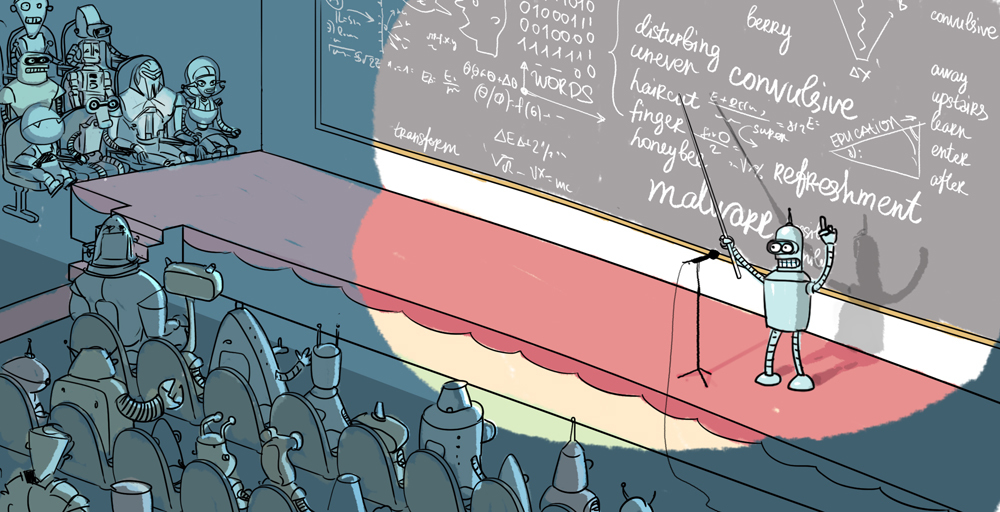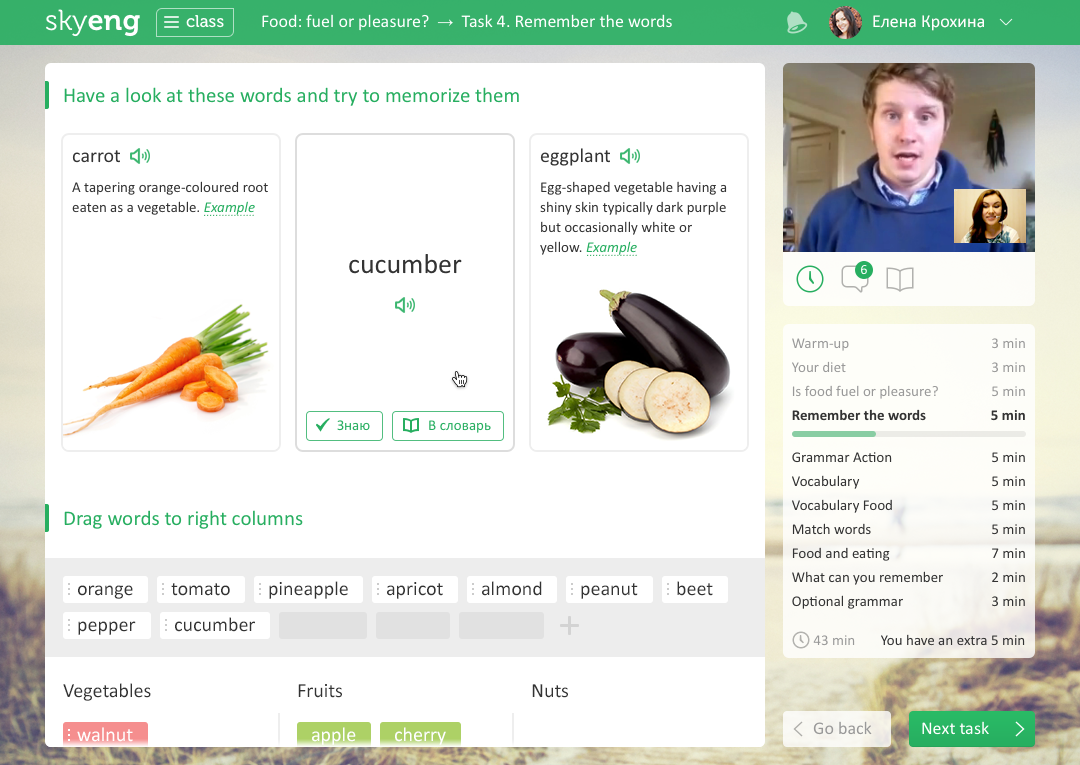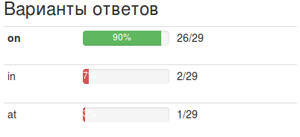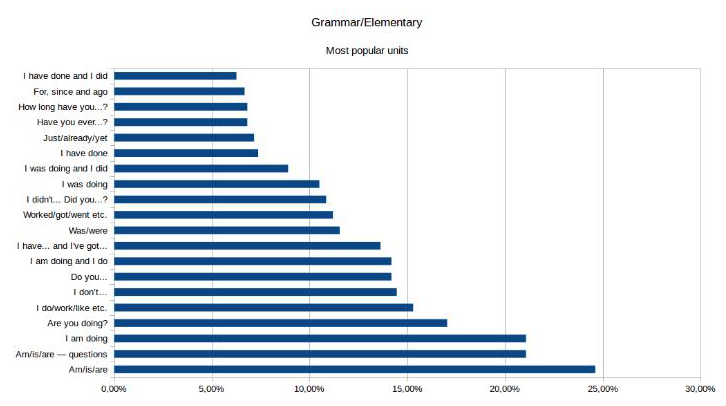Can a car teach english?

Bitcoin bot named after Donald Trump, AlphaGo victory over one of the strongest players in go, Lee Sedol, learning English - what unites these three situations? Everywhere in varying degrees, there is machine learning.
A computer can not only generate a plot line, like Scheherazade, or respond to letters instead of users, like Google Smart Reply, but also create the perfect English textbooks.
')
To help the teacher
At Skyeng, all teachers teach lessons using the Vimbox interactive online platform. All lesson materials, exercises, texts, audio and video files are stored on the platform. The lesson on Vimbox is literally planned by the minute: the teacher sees clues about what questions to ask the student, how best to work out the exercise and what to ask at home. Classes are held in an interactive format - the teacher sees how the student performs the exercises, which words he adds to the dictionary and which grammatical constructions make him difficult; while he can quickly help, explain the desired topic.
In the process a large amount of statistical data is collected. The platform records all the actions of the student and the teacher - how much they spoke, what language, how quickly the student did the exercises, what answers he got and where the teacher helped him. We can estimate the amount of homework, the speed of interaction with texts and exercises, the volume of explanations, the number of records listened to and many other parameters of interaction between the teacher and student in the classroom. The student can also give an assessment to the lesson's materials and to the teacher (the teacher does not see this assessment).

This dataset serves as an assistant to the teacher. Before each lesson, the system will remind him how much vocabulary the student has, what problems he had encountered in previous classes, what tasks were issued and how quickly the student coped with them, etc., up to his interests and hobbies. This is an important help, because the teacher can not remember all the details about each of his students. However, while the teacher analyzes this information independently and builds a lesson based on his own conclusions. Can a learning machine help him?
We think so. The amount of information collected during the lessons is so great that the teacher simply cannot digest it all in five minutes of preparation for the lesson. And the car - completely. Moreover, she can compare the data of a particular student with a database of all students, identify patterns, and on the basis of this entire array, analyze the current lesson “on the fly”, giving the teacher tips: the student will have problems with this grammatical construction ; This task can be skipped because it will not cause any difficulties, we replace it with this one; This topic is interesting to the student, and with this, he will most likely “close”, etc. The learning machine becomes a kind of second, backstage tutor that improves the effectiveness of the lesson.
The use of machine learning is beneficial to us and commercially:
- saves time teachers and methodologists. AI can take on both routine work and basic analytics;
- the efficiency of teachers is increased. The machine will always tell you if the teacher has forgotten something, missed or made a mistake;
- we see a lot of new opportunities. We can create unique products that are not available to us before;
- Finally, with good reason we can talk about their high-tech marketing materials.
Semantic analysis
 Another task from the field of language learning that can be successfully solved by machine learning is the creation of a semantic analyzer. Suppose you are reading a text on your favorite website or a post on a social network. You come across an unfamiliar word in English, you need its translation in this context. Not all variants of the word meaning presented in the English-Russian dictionary, and not the machine translation of the entire phrase, but the translation of the given word in a given place. The semantic “parser” analyzes all the words in the text and the connections between them, makes markup to extract the relevant meaning of the desired word.
Another task from the field of language learning that can be successfully solved by machine learning is the creation of a semantic analyzer. Suppose you are reading a text on your favorite website or a post on a social network. You come across an unfamiliar word in English, you need its translation in this context. Not all variants of the word meaning presented in the English-Russian dictionary, and not the machine translation of the entire phrase, but the translation of the given word in a given place. The semantic “parser” analyzes all the words in the text and the connections between them, makes markup to extract the relevant meaning of the desired word.To score all possible semantic links manually is almost impossible task. Here machine learning also comes to the rescue. The teacher in the course of a normal lesson simply “corrects” the automatic translation, and the analyzer, looking at the surrounding text, tries to find and remember all the patterns. Several such amendments - and the result of the translation becomes close to ideal.
A semantic analyzer will help you read texts, immediately receive relevant translations and add words in the correct meaning to your personal dictionary. The Vimbox dictionary is functionally related to a mobile application that is used to repeat words between lessons. The work of a mobile application is based on an algorithm that copies the systematic work of long-term memory, so memorizing words does not occur randomly, but at certain intervals. But this is a topic for a separate publication, which we are also preparing.
Perfect tutorial
The process of improving the content of educational materials is an important task, which concerns all world textbook publishers, such as Oxford University Press, Macmillan, Cambridge and Pearson. An invaluable assistance in this matter is provided by a rich statistical base about the relationship between the student and the teacher, compiled by the Skyeng school.
We analyzed 308,000 lessons on the Vimbox platform and came up with interesting conclusions. For example, there are exercises that teachers regularly miss and do not ask their students. There are exercises where the number of correct answers reaches 98%. We wondered - what is the meaning of such exercises, are they not too easy and obvious from the point of view of the student? Do they have a pedagogical effect?

The teacher skips this or that exercise based on his own experience and intuition. Using machine learning algorithms and accumulated data, we can create a system that simulates the experience and intuition of all our teachers at once, and create with it the “ideal lesson” for each student, and from such lessons - a personalized “ideal textbook”.

In teaching English, you can analyze the textbook and create some sort of Google Knowledge Graph. For example, in what sequence is the previously studied material repeated, both lexical and grammatical, whether the grammar is being studied correctly, how closely the topics studied are interrelated. You can identify the optimal length of listening for a particular level of knowledge of English, adjust the display of videos, the optimal pattern of alternation of written and oral exercises - all this will be possible with the help of machine learning. We will be able to analyze typical mistakes in the students' written work in our Essay tool and check the work in semi-automatic mode with issuing hints for optimizing work.
We are still at the very beginning of the way, so we are actively interested in all the latest developments in machine learning, we are trying to participate in experiments related to this topic. One such experiment is the BlackBoxChallenge competition, which is partnering with the Skyeng School. The connoisseurs of the Python language can try their hand at creating artificial intelligence — an agent traveling to the Black Box, where unknown adventures and riddles await him. At the entrance, the participants do not have any information about what is happening in the Box, and they need to create an Agent who can learn how to play the game with unknown rules.
The competition is coming to an end - the acceptance of decisions ends on May 30.
The prize fund is 600,000 rubles, now about 1,280 people are fighting for it.
Source: https://habr.com/ru/post/301150/
All Articles